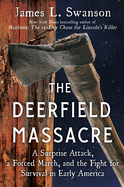
The nightmarish ordeal of a remote early American outpost--and the efforts to preserve its history in the American consciousness--is the absorbing focus of The Deerfield Massacre by historian James L. Swanson (Chasing King's Killer; "The President Has Been Shot!"). On February 29, 1704, the roughly 300 residents of Deerfield, a wilderness outpost on the western edge of the Massachusetts colony, awoke to tomahawks hacking at their doors and flames consuming their homes. Approximately 250 Native warriors and their French allies slaughtered almost 50 townspeople and forced 112 captives back to Canada. This represented an "early volley in a larger war," known as Queen Anne's War, between the French and English. The raid's "great prize" included Deerfield's spiritual leader, Reverend John Williams, and most of his family.
Relying on Williams's published narrative of his captivity in "New France," Swanson imagines the thoughts and experiences of those who witnessed the deaths of loved ones or lost others to their assimilation into Native tribes. He takes a novel approach in the final third of the book as he follows Deerfield's story in American memory, illuminating the ways history is retold in each succeeding generation's various preservation efforts. It is an apt coda to a violent episode that has left a "holy relic": a massive hatchet-scarred door known as the Old Indian Door. The Deerfield Massacre is a fascinating and dramatic tale of a "long-lost America" whose afterlife still has something to say about faith, survival, and redemption. --Peggy Kurkowski, book reviewer and copywriter in Denver

